安徽省2021年中考英语语法专题突破十三几个特殊的简单句
文档属性
| 名称 | 安徽省2021年中考英语语法专题突破十三几个特殊的简单句 |  | |
| 格式 | zip | ||
| 文件大小 | 1.0MB | ||
| 资源类型 | 教案 | ||
| 版本资源 | 通用版 | ||
| 科目 | 英语 | ||
| 更新时间 | 2021-01-06 08:04:55 | ||
图片预览

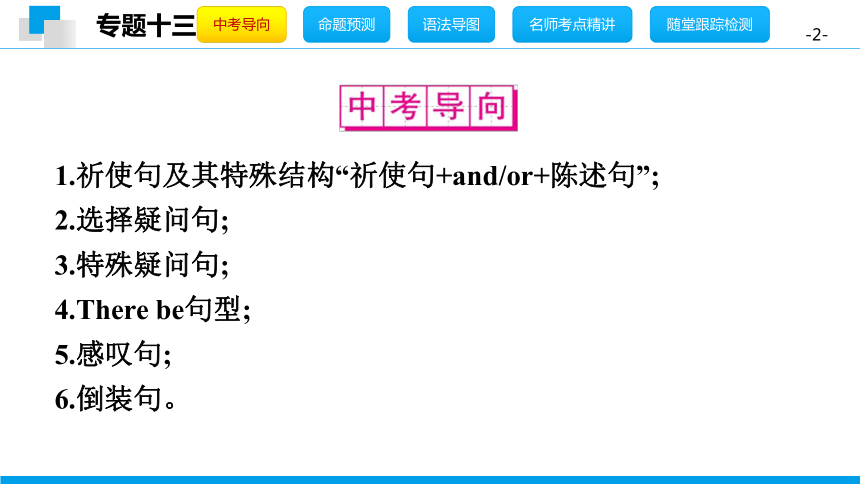
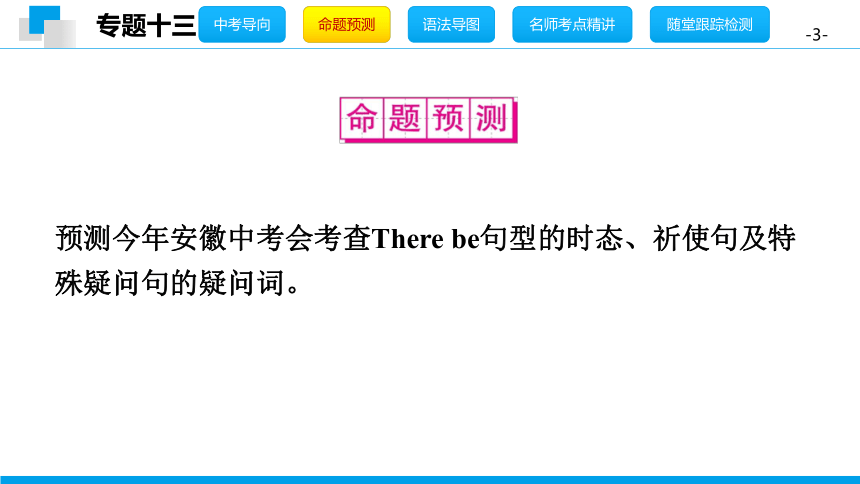
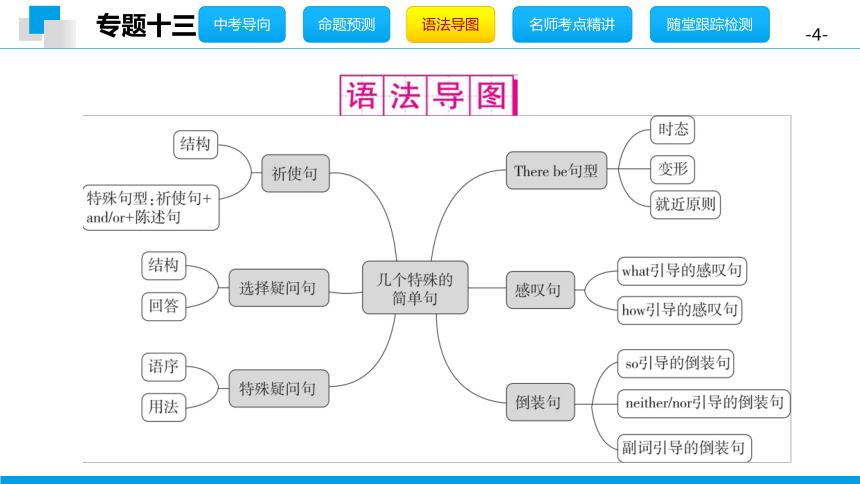
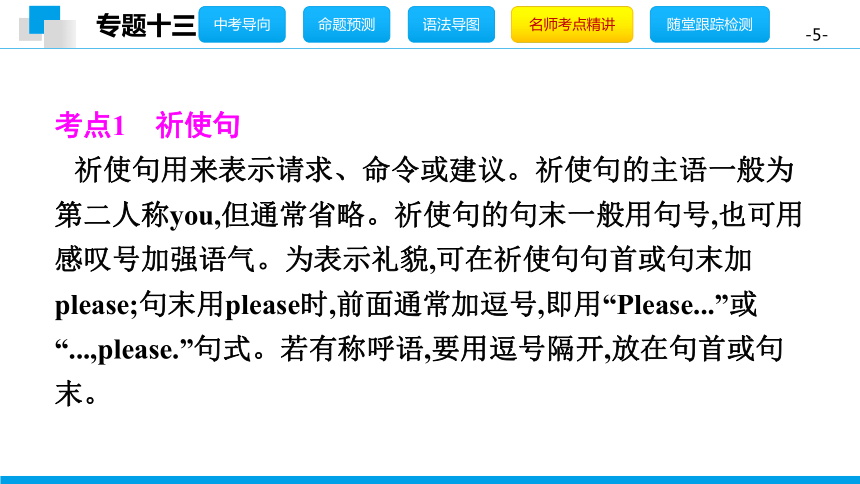
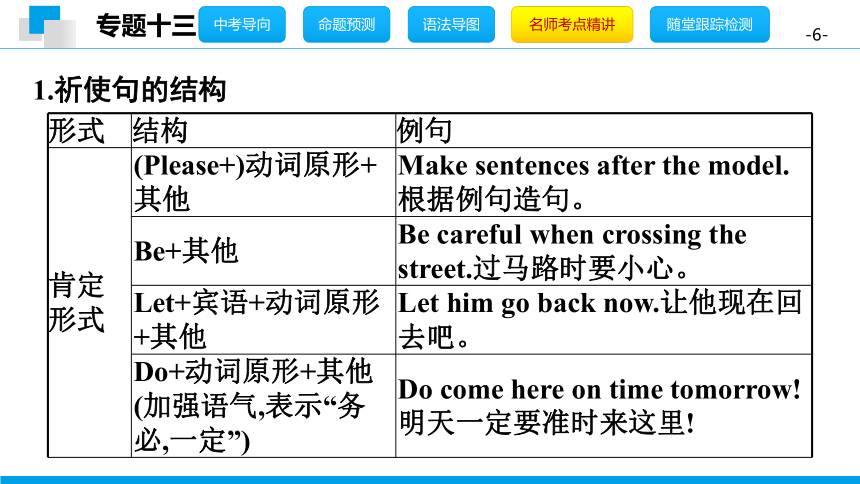
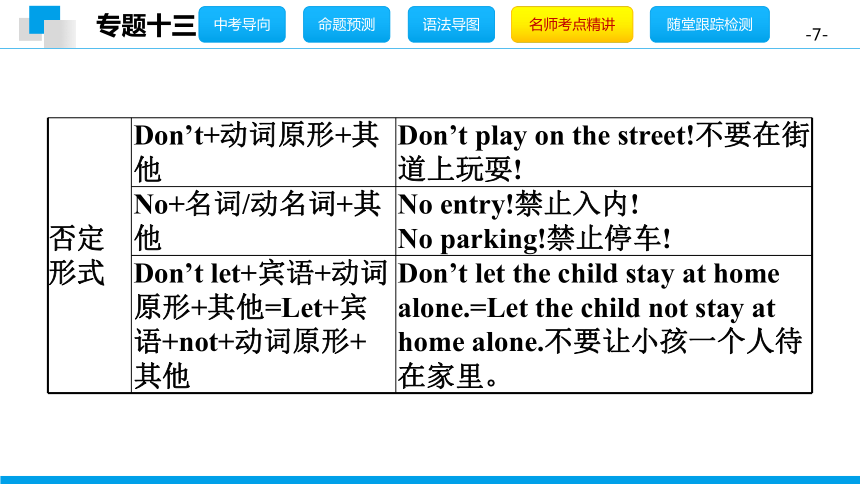
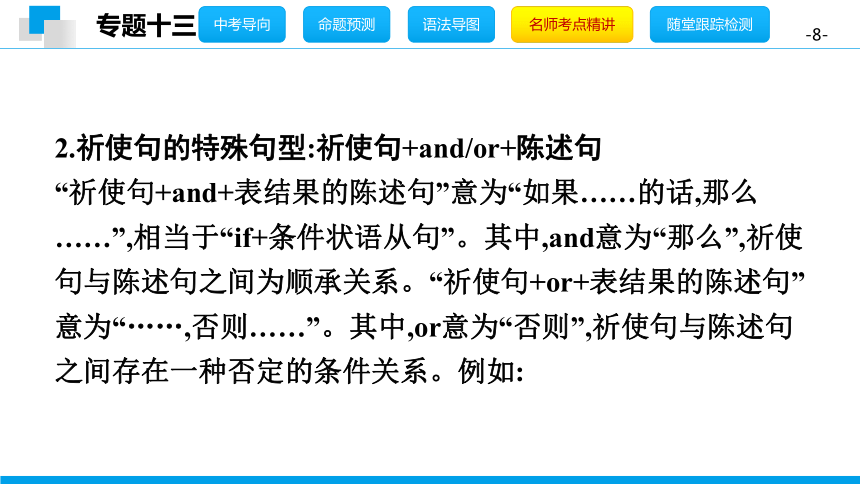
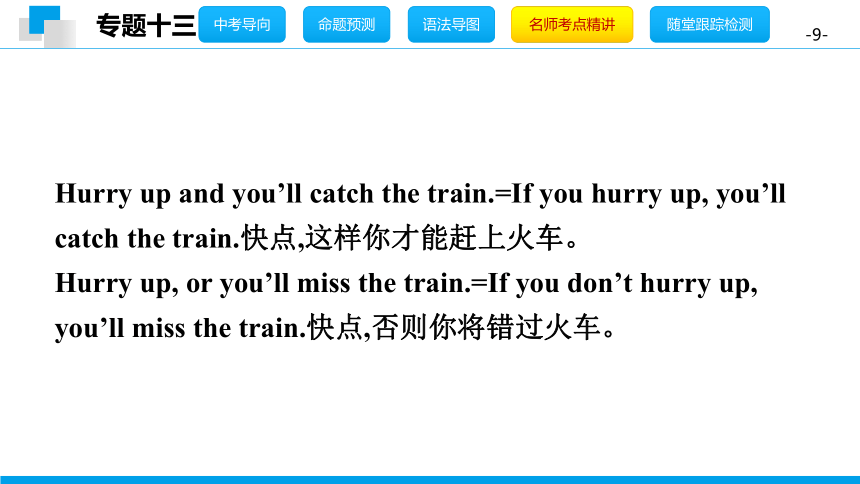
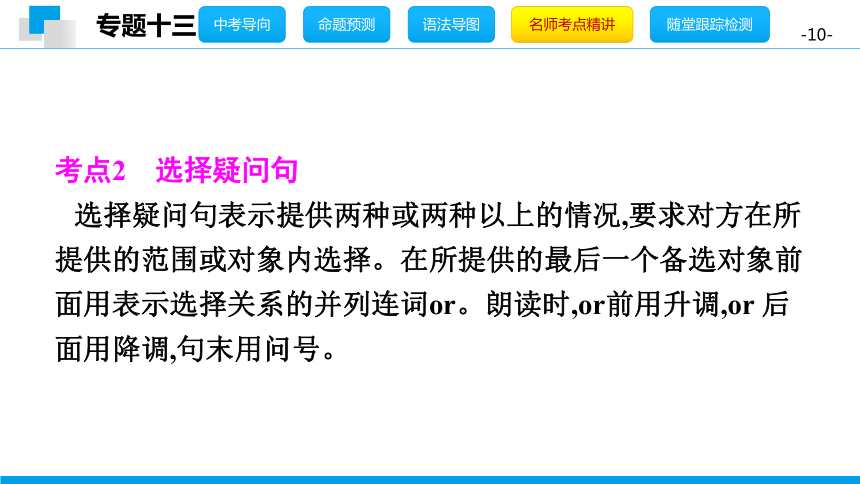
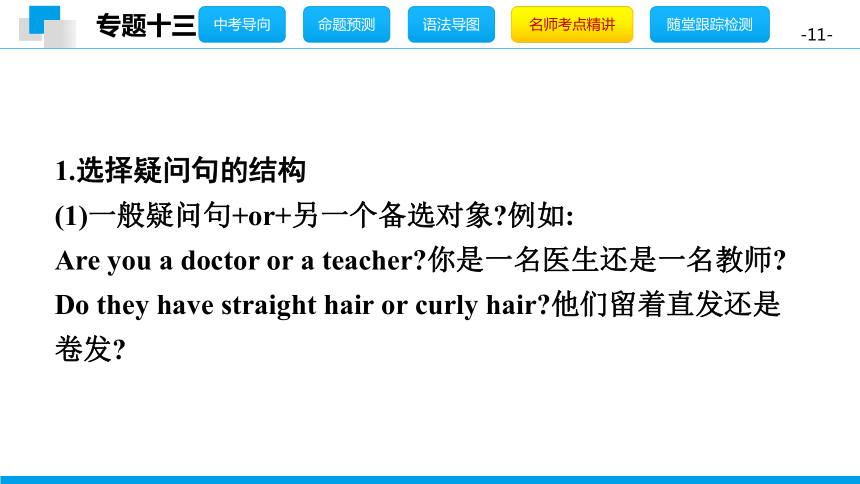
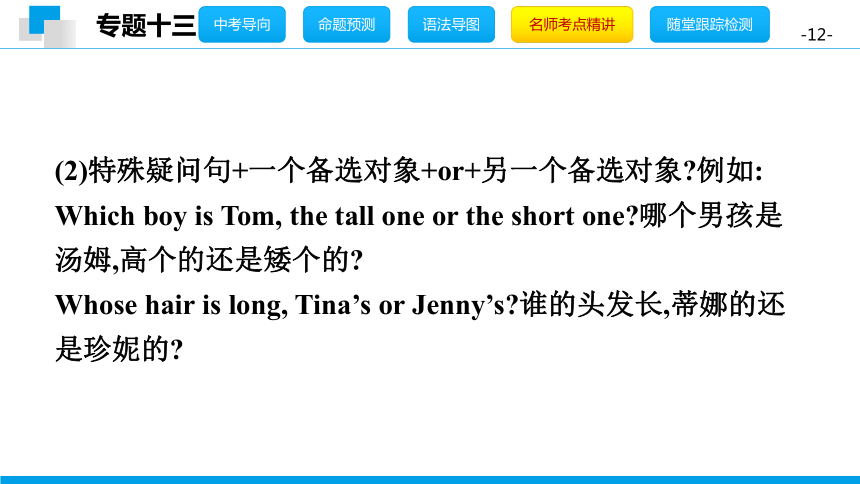
文档简介
(共41张PPT)
专题十三 几个特殊的简单句
1.祈使句及其特殊结构“祈使句+and/or+陈述句”;
2.选择疑问句;
3.特殊疑问句;
4.There
be句型;
5.感叹句;
6.倒装句。
预测今年安徽中考会考查There
be句型的时态、祈使句及特殊疑问句的疑问词。
考点1 祈使句
祈使句用来表示请求、命令或建议。祈使句的主语一般为第二人称you,但通常省略。祈使句的句末一般用句号,也可用感叹号加强语气。为表示礼貌,可在祈使句句首或句末加please;句末用please时,前面通常加逗号,即用“Please...”或“...,please.”句式。若有称呼语,要用逗号隔开,放在句首或句末。
1.祈使句的结构
形式
结构
例句
肯定
形式
(Please+)动词原形+其他
Make
sentences
after
the
model.根据例句造句。
Be+其他
Be
careful
when
crossing
the
street.过马路时要小心。
Let+宾语+动词原形+其他
Let
him
go
back
now.让他现在回去吧。
Do+动词原形+其他(加强语气,表示“务必,一定”)
Do
come
here
on
time
tomorrow!明天一定要准时来这里!
否定
形式
Don’t+动词原形+其他
Don’t
play
on
the
street!不要在街道上玩耍!
No+名词/动名词+其他
No
entry!禁止入内!
No
parking!禁止停车!
Don’t
let+宾语+动词原形+其他=Let+宾语+not+动词原形+其他
Don’t
let
the
child
stay
at
home
alone.=Let
the
child
not
stay
at
home
alone.不要让小孩一个人待在家里。
2.祈使句的特殊句型:祈使句+and/or+陈述句
“祈使句+and+表结果的陈述句”意为“如果……的话,那么……”,相当于“if+条件状语从句”。其中,and意为“那么”,祈使句与陈述句之间为顺承关系。“祈使句+or+表结果的陈述句”意为“……,否则……”。其中,or意为“否则”,祈使句与陈述句之间存在一种否定的条件关系。例如:
Hurry
up
and
you’ll
catch
the
train.=If
you
hurry
up,
you’ll
catch
the
train.快点,这样你才能赶上火车。
Hurry
up,
or
you’ll
miss
the
train.=If
you
don’t
hurry
up,
you’ll
miss
the
train.快点,否则你将错过火车。
考点2 选择疑问句
选择疑问句表示提供两种或两种以上的情况,要求对方在所提供的范围或对象内选择。在所提供的最后一个备选对象前面用表示选择关系的并列连词or。朗读时,or前用升调,or
后面用降调,句末用问号。
1.选择疑问句的结构
(1)一般疑问句+or+另一个备选对象?例如:
Are
you
a
doctor
or
a
teacher?你是一名医生还是一名教师?
Do
they
have
straight
hair
or
curly
hair?他们留着直发还是卷发?
(2)特殊疑问句+一个备选对象+or+另一个备选对象?例如:
Which
boy
is
Tom,
the
tall
one
or
the
short
one?哪个男孩是汤姆,高个的还是矮个的?
Whose
hair
is
long,
Tina’s
or
Jenny’s?谁的头发长,蒂娜的还是珍妮的?
2.选择疑问句的回答
回答选择疑问句时,一般在所提供的备选对象范围内选择,有时也要视具体情况作灵活处理,但不能用“Yes/No”来回答,一般用一个完整的陈述句或其简略形式来回答。
—Are
you
going
there
by
train
or
by
plane?你坐火车去那里还是坐飞机去?
—By
train.坐火车。
—Is
he
thin
or
heavy?他是瘦还是胖?
—He’s
a
little
heavy.他有点胖。
考点3 特殊疑问句
以特殊疑问词开头,对陈述句中某一部分进行提问的句子叫特殊疑问句。常用的特殊疑问词有what,
which,
whose,
who,
whom,
when,
where,
how,
why等。回答特殊疑问句时,应针对提问内容作答。
1.特殊疑问句的两种语序
(1)特殊疑问词作主语或主语的定语时的语序:特殊疑问词(+主语)+谓语+其他?例如:
Who
is
singing
in
the
room?谁正在房间里唱歌?
(2)特殊疑问词作其他成分时的语序:特殊疑问词+系动词/助动词/情态动词+主语(+谓语)+其他?例如:
What
does
she
look
like?她长什么样?
2.特殊疑问词的用法
(1)疑问代词有what,which,whose,who,whom。其用法如下:
疑问代词
用法
what
对事物、抽象概念、职业或身份提问
which
对具体某个人或物提问
whose
对物主提问
who
对人物身份提问
whom
对表示人物的宾语提问
(2)疑问副词有when,where,how,why。其用法如下:
疑问副词
用法
when
对时间提问
where
对具体地点提问
why
对原因提问
how
对方式或程度提问
(3)疑问词组及其用法:
what
time提问具体时刻
what
day提问星期几
what
date提问日期
what
size提问尺寸
what
color提问颜色
how
old提问年龄
how
much提问价格
how
much/many提问数量
how
far提问距离
how
long
提问时间或长度
how
fast提问速度
how
tall/high提问高度
how
heavy提问重量
how
often提问频率
how
soon
提问还有多久
how
many
times提问具体次数
考点4 There
be句型
There
be句型表示“在某时间或某处存在某人或某物”,其结构为“There+be动词+主语(+其他成分)”,地点状语也可以置于句首。例如:
There
are
fifty?two
students
in
our
class.我们班有52名学生。
1.There
be句型的时态
时态
结构
一般现在时
There
is/are+主语(+其他成分)
一般过去时
There
was/were+主语(+其他成分)
一般将来时
There
is/are
going
to
be/will
be+主语(+其他成分)
现在完成时
There
has/have
been+主语(+其他成分)
2.There
be句型的变形
(1)There+may/can/must/used
to+be+主语(+其他成分)
(2)There+lies/remains/stands/lives/comes等表示“存在”意义的不及物动词+主语(+其他成分)
(3)There+seems/happens/appears
to+be+主语(+其他成分)
3.There
be句型的主谓一致
There
be句型中的谓语动词遵循“就近原则”,即谓语动词的单复数与离它最近的主语保持一致。例如:?
There
are
some
bananas
and
an
orange
on
the
table.桌子上有一些香蕉和一个橘子。
=There
is
an
orange
and
some
bananas
on
the
table.桌子上有一个橘子和一些香蕉。
There
be句型和have的区别
There
be句型表示“存在”,强调“在某时间或某个地点有某人或某物”,不表示所属关系。have表示所属关系,强调“某人或某物有……”。
考点5 感叹句
感叹句是表示惊讶、赞美、喜悦、愤怒等情感的句子,通常由what或how引导。what修饰名词,how修饰形容词或副词。
形式
结构
例句
what引导的感叹句
What+a/an(+形容词)+可数名词单数(+主语+谓语)!
What
an
honest
boy(he
is)!(他是)一个多么诚实的孩子呀!
What
a
shame!真倒霉!
What(+形容词)+可数名词复数(+主语+谓语)!
What
funny
stories
(they
are)!(它们是)多么有趣的故事啊!
What
fools!真是些笨蛋!
What(+形容词)+不可数名词(+主语+谓语)!
What
terrible
weather
(we
met)!(我们遇到了)多么可怕的天气啊!
What
luck!真幸运!
how引导的感叹句
How+形容词/副词(+主语+谓语)!
How
happy
(he
is)!(他是)多么幸福啊!
How+形容词+a/an+可数名词单数(+主语+谓语)!
How
happy
a
boy
(he
is)!(他是)一个多么幸福的男孩啊!
How+主语+谓语!
How
time
flies!时光如梭!
考点6 倒装句
1.so引导的倒装句
so引导的倒装句用于肯定句中,表示前面所述的情况也适用于后面的人或物。结构为“so+be动词/助动词/情态动词+主语”,意为“……也一样”。例如:
—I
have
been
to
Sanya
before.我之前去过三亚。
—So
have
I.我也去过。
易混句式:“so+主语+be动词/助动词/情态动词”意为“……的确如此”。该句式是对前面所说的事实加以肯定,上下句中的主语是相同的人或物。例如:
—Lucy
has
been
to
Sanya
before.露西之前去过三亚。
—So
she
has.她的确去过。
2.neither/nor引导的倒装句
neither/nor引导的倒装句用于否定句中,表示前面所述的情况同样不适用于后面的人或物。结构为“neither/nor+be动词/助动词/情态动词+主语”,意为“……同样也不”。例如:
—I
have
never
been
to
Sanya
before.我之前从未去过三亚。
—Neither/Nor
have
I.我也没去过。
易混句式:“neither/nor+主语+be动词/助动词/情态动词”意为“……的确不是这样”。该句式是对前面所说的否定事实加以肯定,上下句中的主语是相同的人或物。例如:
—Lucy
has
never
been
to
Sanya
before.露西之前从未去过三亚。
—Neither/Nor
she
has.她的确没去过。
3.副词引导的倒装句
在以here,
there,
in,
out,
up,
down,
away,
back,
now,
then等副词开头的句子里,如果主语是名词,常用完全倒装结构;若主语是代词,只把副词提前,主谓语序不变。例如:
Out
rushed
the
boys.男孩们冲了出去。
Here
he
comes.他来了。
单项填空
1.—
wonderful
music
the
musician
is
playing!?
—Yes.
Everyone
is
losing
themselves
in
it.(
A
)
A.What
B.What
a
C.How
D.How
a
2.—It
may
be
rainy
tomorrow.
I
am
not
going
climbing
tomorrow.
— .I
have
to
prepare
for
my
test.(
B
)?
A.Neither
I
will
B.Neither
will
I
C.So
I
will
D.So
will
I
3. kind
and
helpful
to
the
people
around
us,
and
we
will
make
the
world
a
nicer
place
to
live
in.(
A
)?
A.Be
B.Being
C.To
be
D.Been
4.— tea
do
you
have?(
C
)?
—Two
cups.
A.How
many
B.How
often
C.How
much
D.How
long
5.—It
is
reported
that
a
kind
of
new
smart
phones
can
test
the
air
quality(质量)
around
you.
— fast
the
technology
develops!(
C
)?
A.What
B.What
a
C.How
D.How
a
6.—Tara
has
made
great
progress
in
English
this
term.
— ,and
.(
A
)?
A.So
she
has;so
have
you
B.So
she
has;so
you
have
C.So
has
she;so
have
you
D.So
has
she;so
you
have
7.I’d
like
to
have
some
more
soup. delicious
it
is!
(
C
)?
A.What
B.What
a
C.How
D.How
a
8.—Shall
we
go
there
by
train by
plane??
—By
plane.(
D
)
A.and
B.also
C.whether
D.or
9.— shall
we
start
the
program?(
A
)?
—Tomorrow
afternoon.
A.When
B.What
C.Where
D.How
10.—Why
are
you
in
such
a
hurry,
John?
—There an
NBA
basketball
game
in
ten
minutes.
(
A
)?
A.will
be
B.will
have
C.would
be
D.would
have
11.—
useful
tool
the
computer
is!?
—That’s
true
if
you
put
it
into
good
use.(
D
)
A.How
B.How
a
C.What
D.What
a
12.
work
for
so
long.
Everyone
needs
to
relax
to
prepare
himself
for
the
next
day.(
B
)?
A.Not
B.Don’t
C.Not
to
D.Don’t
to
13.—What’s
in
the
glass?
— is
some
milk
in
it.(
D
)?
A.It
B.They
C.That
D.There
14.— is
it
from
here
to
the
train
station??
—It’s
about
10
minutes’
walk.(
B
)
A.How
long
B.How
far
C.How
soon
D.How
much
专题十三 几个特殊的简单句
1.祈使句及其特殊结构“祈使句+and/or+陈述句”;
2.选择疑问句;
3.特殊疑问句;
4.There
be句型;
5.感叹句;
6.倒装句。
预测今年安徽中考会考查There
be句型的时态、祈使句及特殊疑问句的疑问词。
考点1 祈使句
祈使句用来表示请求、命令或建议。祈使句的主语一般为第二人称you,但通常省略。祈使句的句末一般用句号,也可用感叹号加强语气。为表示礼貌,可在祈使句句首或句末加please;句末用please时,前面通常加逗号,即用“Please...”或“...,please.”句式。若有称呼语,要用逗号隔开,放在句首或句末。
1.祈使句的结构
形式
结构
例句
肯定
形式
(Please+)动词原形+其他
Make
sentences
after
the
model.根据例句造句。
Be+其他
Be
careful
when
crossing
the
street.过马路时要小心。
Let+宾语+动词原形+其他
Let
him
go
back
now.让他现在回去吧。
Do+动词原形+其他(加强语气,表示“务必,一定”)
Do
come
here
on
time
tomorrow!明天一定要准时来这里!
否定
形式
Don’t+动词原形+其他
Don’t
play
on
the
street!不要在街道上玩耍!
No+名词/动名词+其他
No
entry!禁止入内!
No
parking!禁止停车!
Don’t
let+宾语+动词原形+其他=Let+宾语+not+动词原形+其他
Don’t
let
the
child
stay
at
home
alone.=Let
the
child
not
stay
at
home
alone.不要让小孩一个人待在家里。
2.祈使句的特殊句型:祈使句+and/or+陈述句
“祈使句+and+表结果的陈述句”意为“如果……的话,那么……”,相当于“if+条件状语从句”。其中,and意为“那么”,祈使句与陈述句之间为顺承关系。“祈使句+or+表结果的陈述句”意为“……,否则……”。其中,or意为“否则”,祈使句与陈述句之间存在一种否定的条件关系。例如:
Hurry
up
and
you’ll
catch
the
train.=If
you
hurry
up,
you’ll
catch
the
train.快点,这样你才能赶上火车。
Hurry
up,
or
you’ll
miss
the
train.=If
you
don’t
hurry
up,
you’ll
miss
the
train.快点,否则你将错过火车。
考点2 选择疑问句
选择疑问句表示提供两种或两种以上的情况,要求对方在所提供的范围或对象内选择。在所提供的最后一个备选对象前面用表示选择关系的并列连词or。朗读时,or前用升调,or
后面用降调,句末用问号。
1.选择疑问句的结构
(1)一般疑问句+or+另一个备选对象?例如:
Are
you
a
doctor
or
a
teacher?你是一名医生还是一名教师?
Do
they
have
straight
hair
or
curly
hair?他们留着直发还是卷发?
(2)特殊疑问句+一个备选对象+or+另一个备选对象?例如:
Which
boy
is
Tom,
the
tall
one
or
the
short
one?哪个男孩是汤姆,高个的还是矮个的?
Whose
hair
is
long,
Tina’s
or
Jenny’s?谁的头发长,蒂娜的还是珍妮的?
2.选择疑问句的回答
回答选择疑问句时,一般在所提供的备选对象范围内选择,有时也要视具体情况作灵活处理,但不能用“Yes/No”来回答,一般用一个完整的陈述句或其简略形式来回答。
—Are
you
going
there
by
train
or
by
plane?你坐火车去那里还是坐飞机去?
—By
train.坐火车。
—Is
he
thin
or
heavy?他是瘦还是胖?
—He’s
a
little
heavy.他有点胖。
考点3 特殊疑问句
以特殊疑问词开头,对陈述句中某一部分进行提问的句子叫特殊疑问句。常用的特殊疑问词有what,
which,
whose,
who,
whom,
when,
where,
how,
why等。回答特殊疑问句时,应针对提问内容作答。
1.特殊疑问句的两种语序
(1)特殊疑问词作主语或主语的定语时的语序:特殊疑问词(+主语)+谓语+其他?例如:
Who
is
singing
in
the
room?谁正在房间里唱歌?
(2)特殊疑问词作其他成分时的语序:特殊疑问词+系动词/助动词/情态动词+主语(+谓语)+其他?例如:
What
does
she
look
like?她长什么样?
2.特殊疑问词的用法
(1)疑问代词有what,which,whose,who,whom。其用法如下:
疑问代词
用法
what
对事物、抽象概念、职业或身份提问
which
对具体某个人或物提问
whose
对物主提问
who
对人物身份提问
whom
对表示人物的宾语提问
(2)疑问副词有when,where,how,why。其用法如下:
疑问副词
用法
when
对时间提问
where
对具体地点提问
why
对原因提问
how
对方式或程度提问
(3)疑问词组及其用法:
what
time提问具体时刻
what
day提问星期几
what
date提问日期
what
size提问尺寸
what
color提问颜色
how
old提问年龄
how
much提问价格
how
much/many提问数量
how
far提问距离
how
long
提问时间或长度
how
fast提问速度
how
tall/high提问高度
how
heavy提问重量
how
often提问频率
how
soon
提问还有多久
how
many
times提问具体次数
考点4 There
be句型
There
be句型表示“在某时间或某处存在某人或某物”,其结构为“There+be动词+主语(+其他成分)”,地点状语也可以置于句首。例如:
There
are
fifty?two
students
in
our
class.我们班有52名学生。
1.There
be句型的时态
时态
结构
一般现在时
There
is/are+主语(+其他成分)
一般过去时
There
was/were+主语(+其他成分)
一般将来时
There
is/are
going
to
be/will
be+主语(+其他成分)
现在完成时
There
has/have
been+主语(+其他成分)
2.There
be句型的变形
(1)There+may/can/must/used
to+be+主语(+其他成分)
(2)There+lies/remains/stands/lives/comes等表示“存在”意义的不及物动词+主语(+其他成分)
(3)There+seems/happens/appears
to+be+主语(+其他成分)
3.There
be句型的主谓一致
There
be句型中的谓语动词遵循“就近原则”,即谓语动词的单复数与离它最近的主语保持一致。例如:?
There
are
some
bananas
and
an
orange
on
the
table.桌子上有一些香蕉和一个橘子。
=There
is
an
orange
and
some
bananas
on
the
table.桌子上有一个橘子和一些香蕉。
There
be句型和have的区别
There
be句型表示“存在”,强调“在某时间或某个地点有某人或某物”,不表示所属关系。have表示所属关系,强调“某人或某物有……”。
考点5 感叹句
感叹句是表示惊讶、赞美、喜悦、愤怒等情感的句子,通常由what或how引导。what修饰名词,how修饰形容词或副词。
形式
结构
例句
what引导的感叹句
What+a/an(+形容词)+可数名词单数(+主语+谓语)!
What
an
honest
boy(he
is)!(他是)一个多么诚实的孩子呀!
What
a
shame!真倒霉!
What(+形容词)+可数名词复数(+主语+谓语)!
What
funny
stories
(they
are)!(它们是)多么有趣的故事啊!
What
fools!真是些笨蛋!
What(+形容词)+不可数名词(+主语+谓语)!
What
terrible
weather
(we
met)!(我们遇到了)多么可怕的天气啊!
What
luck!真幸运!
how引导的感叹句
How+形容词/副词(+主语+谓语)!
How
happy
(he
is)!(他是)多么幸福啊!
How+形容词+a/an+可数名词单数(+主语+谓语)!
How
happy
a
boy
(he
is)!(他是)一个多么幸福的男孩啊!
How+主语+谓语!
How
time
flies!时光如梭!
考点6 倒装句
1.so引导的倒装句
so引导的倒装句用于肯定句中,表示前面所述的情况也适用于后面的人或物。结构为“so+be动词/助动词/情态动词+主语”,意为“……也一样”。例如:
—I
have
been
to
Sanya
before.我之前去过三亚。
—So
have
I.我也去过。
易混句式:“so+主语+be动词/助动词/情态动词”意为“……的确如此”。该句式是对前面所说的事实加以肯定,上下句中的主语是相同的人或物。例如:
—Lucy
has
been
to
Sanya
before.露西之前去过三亚。
—So
she
has.她的确去过。
2.neither/nor引导的倒装句
neither/nor引导的倒装句用于否定句中,表示前面所述的情况同样不适用于后面的人或物。结构为“neither/nor+be动词/助动词/情态动词+主语”,意为“……同样也不”。例如:
—I
have
never
been
to
Sanya
before.我之前从未去过三亚。
—Neither/Nor
have
I.我也没去过。
易混句式:“neither/nor+主语+be动词/助动词/情态动词”意为“……的确不是这样”。该句式是对前面所说的否定事实加以肯定,上下句中的主语是相同的人或物。例如:
—Lucy
has
never
been
to
Sanya
before.露西之前从未去过三亚。
—Neither/Nor
she
has.她的确没去过。
3.副词引导的倒装句
在以here,
there,
in,
out,
up,
down,
away,
back,
now,
then等副词开头的句子里,如果主语是名词,常用完全倒装结构;若主语是代词,只把副词提前,主谓语序不变。例如:
Out
rushed
the
boys.男孩们冲了出去。
Here
he
comes.他来了。
单项填空
1.—
wonderful
music
the
musician
is
playing!?
—Yes.
Everyone
is
losing
themselves
in
it.(
A
)
A.What
B.What
a
C.How
D.How
a
2.—It
may
be
rainy
tomorrow.
I
am
not
going
climbing
tomorrow.
— .I
have
to
prepare
for
my
test.(
B
)?
A.Neither
I
will
B.Neither
will
I
C.So
I
will
D.So
will
I
3. kind
and
helpful
to
the
people
around
us,
and
we
will
make
the
world
a
nicer
place
to
live
in.(
A
)?
A.Be
B.Being
C.To
be
D.Been
4.— tea
do
you
have?(
C
)?
—Two
cups.
A.How
many
B.How
often
C.How
much
D.How
long
5.—It
is
reported
that
a
kind
of
new
smart
phones
can
test
the
air
quality(质量)
around
you.
— fast
the
technology
develops!(
C
)?
A.What
B.What
a
C.How
D.How
a
6.—Tara
has
made
great
progress
in
English
this
term.
— ,and
.(
A
)?
A.So
she
has;so
have
you
B.So
she
has;so
you
have
C.So
has
she;so
have
you
D.So
has
she;so
you
have
7.I’d
like
to
have
some
more
soup. delicious
it
is!
(
C
)?
A.What
B.What
a
C.How
D.How
a
8.—Shall
we
go
there
by
train by
plane??
—By
plane.(
D
)
A.and
B.also
C.whether
D.or
9.— shall
we
start
the
program?(
A
)?
—Tomorrow
afternoon.
A.When
B.What
C.Where
D.How
10.—Why
are
you
in
such
a
hurry,
John?
—There an
NBA
basketball
game
in
ten
minutes.
(
A
)?
A.will
be
B.will
have
C.would
be
D.would
have
11.—
useful
tool
the
computer
is!?
—That’s
true
if
you
put
it
into
good
use.(
D
)
A.How
B.How
a
C.What
D.What
a
12.
work
for
so
long.
Everyone
needs
to
relax
to
prepare
himself
for
the
next
day.(
B
)?
A.Not
B.Don’t
C.Not
to
D.Don’t
to
13.—What’s
in
the
glass?
— is
some
milk
in
it.(
D
)?
A.It
B.They
C.That
D.There
14.— is
it
from
here
to
the
train
station??
—It’s
about
10
minutes’
walk.(
B
)
A.How
long
B.How
far
C.How
soon
D.How
much
同课章节目录
- 词法
- 名词
- 动词和动词短语
- 动词语态
- 动词时态
- 助动词和情态动词
- 非谓语动词
- 冠词
- 代词
- 数词和量词
- 形容词副词及其比较等级
- 介词和介词短语
- 连词和感叹词
- 构词法
- 相似、相近词比较
- 句法
- 陈述句
- 一般疑问句和否定疑问句
- 特殊疑问句及选择疑问句
- 反意疑问句
- 存在句(There be句型)
- 宾语从句
- 定语从句
- 状语从句
- 主谓一致问题
- 简单句
- 并列句
- 复合句
- 主谓一致
- 主、表语从句
- 名词性从句
- 直接引语和间接引语
- 虚拟语气
- 感叹句
- 强调句
- 倒装句
- 祈使句
- 句子的成分
- 句子的分类
- 题型专区
- 单项选择部分
- 易错题
- 完形填空
- 阅读理解
- 词汇练习
- 听说训练
- 句型转换
- 补全对话
- 短文改错
- 翻译
- 书面表达
- 任务型阅读
- 语法填空
- 其他资料
